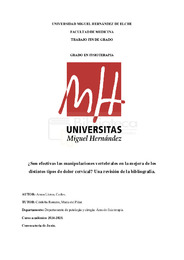Título :
¿Son efectivas las manipulaciones vertebrales en la mejora de los distintos tipos de dolor cervical? Una revisión de la bibliografía. |
Autor :
Arnau Llorca, Carlos |
Tutor:
Córdoba Romero, María del Pilar |
Editor :
Universidad Miguel Hernández |
Departamento:
Departamentos de la UMH::Patología y Cirugía |
Fecha de publicación:
2025-05-21 |
URI :
https://hdl.handle.net/11000/37438 |
Resumen :
Introducción y objetivo: El dolor cervical es una de las principales causas de discapacidad a nivel mundial y una consulta frecuente en fisioterapia. Las manipulaciones vertebrales (MV) se han propuesto como un tratamiento eficaz para reducir el dolor y mejorar la función cervical. El objetivo de esta revisión fue analizar la eficacia de las MV en pacientes con dolor de cuello, basándose en la evidencia
científica.
Material y métodos: Se realizó una revisión bibliográfica en las bases de datos PubMed, Scopus, Cochrane y PEDro, seleccionando ensayos clínicos controlados publicados entre 2013 y 2023. Se incluyeron estudios con pacientes mayores de edad con dolor cervical, donde se aplicaron MV como tratamiento principal. Se analizaron las variables de dolor, movilidad y discapacidad.
Resultados: Se seleccionaron 12 estudios que cumplieron los criterios de inclusión. La mayoría mostraron una mejora significativa del dolor y la movilidad cervical tras la aplicación de MV, El 75% de estudios manipularon segmentos vertebrales a nivel torácico. El 58,33% de artículos midieron tanto los efectos sobre el dolor como el rango articular. El 75% de artículos escogieron pacientes con cervicalgia crónica.
Conclusiones: Las MV tienen efectos moderados para reducir el dolor cervical y mejorar la movilidad a corto plazo. No obstante, su superioridad frente a otras técnicas no está completamente establecida, por lo que se recomienda su aplicación dentro de un abordaje multimodal.
Introduction and Objective: Neck pain is a leading cause of disability worldwide and a frequent reason for consultation in physiotherapy. Spinal manipulations (SM) have been proposed as an effective treatment to reduce pain and improve cervical function. The objective of this review was to analyze the effectiveness of SM in patients with neck pain, based on scientific evidence.
Material and Methods: A bibliographic review was conducted in the PubMed, Scopus, Cochrane, and PEDro databases, selecting controlled clinical trials published between 2013 and 2023. Studies with adult patients with neck pain, where SM was applied as the primary treatment, were included. The variables of pain, mobility, and disability were analyzed.
Results: Twelve studies that met the inclusion criteria were selected. The majority showed a significant improvement in pain and cervical mobility after the application of SM. 75% of the studies manipulated vertebral segments at the thoracic level. 58.33% of the articles measured both the effects on pain and the joint range of motion. 75% of the articles selected patients with chronic neck pain.
Conclusions: SM has moderate effects in reducing neck pain and improving mobility in the short term. However, its superiority over other techniques is not completely established, so its application within a multimodal approach is recommended.
|
Palabras clave/Materias:
Manipulación vertebral
Dolor cervical
Fisioterapia
Terapia manual |
Área de conocimiento :
CDU: Ciencias aplicadas |
Tipo de documento :
info:eu-repo/semantics/bachelorThesis |
Derechos de acceso:
info:eu-repo/semantics/openAccess
Attribution-NonCommercial-NoDerivatives 4.0 Internacional |
Aparece en las colecciones:
TFG - Fisioterapia
|
 La licencia se describe como: Atribución-NonComercial-NoDerivada 4.0 Internacional.
La licencia se describe como: Atribución-NonComercial-NoDerivada 4.0 Internacional.
.png)
